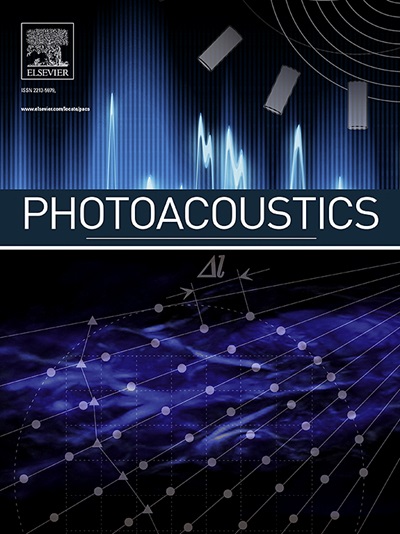Hybrid Fourier-Derivative Analysis: An accurate and fast method for blood flow quantification in photoacoustic microscopy
IF 6.8
1区 医学
Q1 ENGINEERING, BIOMEDICAL
引用次数: 0
Abstract
Photoacoustic microscopy (PAM) enables label-free, quantitative imaging of blood flow and oxygenation in vivo, offering critical insights into microvascular function and tissue metabolism. However, current flow quantification methods suffer from poor accuracy at extreme flow speeds and high computational costs. We present Hybrid Fourier-Derivative Analysis (HFDA), a new method based on frequency analysis of flow-induced modulations in photoacoustic amplitude. Compatible with standard raster scanning, HFDA adaptively integrates Fourier analysis for high-speed flow and derivative analysis for low-speed flow, achieving high accuracy and computational efficiency. Phantom studies validate the accuracy of HFDA across 0.2–20 mm/s, with errors typically less than 7 %. Compared to correlation-based methods, HFDA reduces computational time by 35-fold. In vivo demonstrations in mouse models of hypoxia and hypercapnia further underscore the potential of HFDA as a rapid and precise tool for blood flow quantification in functional and metabolic PAM studies.
混合傅立叶导数分析:一种准确、快速的光声显微镜血流定量方法
光声显微镜(PAM)能够实现无标记的体内血流和氧合定量成像,为微血管功能和组织代谢提供关键见解。然而,目前的流量量化方法在极端流速下精度差,计算成本高。本文提出了一种基于频率分析的混合傅立叶导数分析方法(HFDA)。HFDA兼容标准光栅扫描,自适应集成高速流的傅里叶分析和低速流的导数分析,实现高精度和计算效率。幻影研究验证了HFDA在0.2-20 mm/s范围内的准确性,误差通常小于7 %。与基于相关性的方法相比,HFDA的计算时间减少了35倍。在小鼠缺氧和高碳酸血症模型中的体内实验进一步强调了HFDA作为功能和代谢PAM研究中血流定量的快速和精确工具的潜力。
本文章由计算机程序翻译,如有差异,请以英文原文为准。
求助全文
约1分钟内获得全文
求助全文
来源期刊

Photoacoustics
Physics and Astronomy-Atomic and Molecular Physics, and Optics
CiteScore
11.40
自引率
16.50%
发文量
96
审稿时长
53 days
期刊介绍:
The open access Photoacoustics journal (PACS) aims to publish original research and review contributions in the field of photoacoustics-optoacoustics-thermoacoustics. This field utilizes acoustical and ultrasonic phenomena excited by electromagnetic radiation for the detection, visualization, and characterization of various materials and biological tissues, including living organisms.
Recent advancements in laser technologies, ultrasound detection approaches, inverse theory, and fast reconstruction algorithms have greatly supported the rapid progress in this field. The unique contrast provided by molecular absorption in photoacoustic-optoacoustic-thermoacoustic methods has allowed for addressing unmet biological and medical needs such as pre-clinical research, clinical imaging of vasculature, tissue and disease physiology, drug efficacy, surgery guidance, and therapy monitoring.
Applications of this field encompass a wide range of medical imaging and sensing applications, including cancer, vascular diseases, brain neurophysiology, ophthalmology, and diabetes. Moreover, photoacoustics-optoacoustics-thermoacoustics is a multidisciplinary field, with contributions from chemistry and nanotechnology, where novel materials such as biodegradable nanoparticles, organic dyes, targeted agents, theranostic probes, and genetically expressed markers are being actively developed.
These advanced materials have significantly improved the signal-to-noise ratio and tissue contrast in photoacoustic methods.
 求助内容:
求助内容: 应助结果提醒方式:
应助结果提醒方式:


